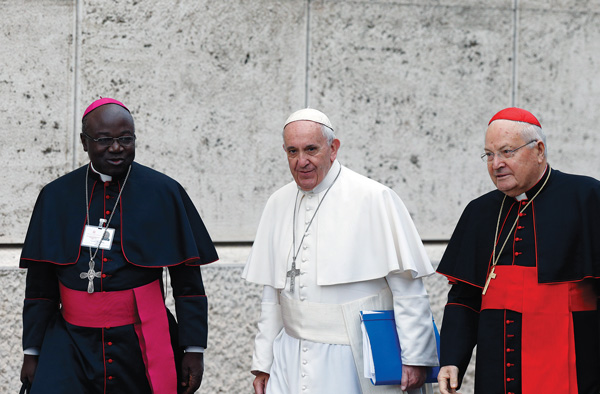
One of the most fascinating elements of the 2015 synod has been the way in which disagreement has been described.
Nobody disputes that inside the synod hall there have been vigorous disagreements. But disagreeing about what the disagreements mean has become almost a synod issue in itself.
Some journalists have tried to frame the discussion as a row between “conservatives” and “progressives,” or “reformers” and “traditionalists.” They paint the picture of a battle over the language the Church uses, and whether or not God’s mercy can be expressed by giving bishops latitude to re-admit civilly married divorces to Communion in particular cases.
According to this view, the opponents of change in these areas are also the critics of the synod’s process, believing that Pope Francis has ‘stacked the deck’ in favor of a particular outcome he wants to see.
But while it’s true that these issues have been the source of, at times, vigorous debate, it’s not always easy to line people up in two opposing camps.
Take the Archbishop of Brisbane in Australia, Archbishop Mark Coleridge, whose synod blog has been a must-read. He has been critical of a number of elements of this new synod, telling journalists that previous synods were “clearer, calmer, and better organized.” And like many synod fathers, he is no fan of the working document, or Instrumentum Laboris (IL), which has been nicknamed the “Instrumentum Laborious.” The IL, says Archbishop Coleridge, is too feeble a framework to support the weight that has been put on it.
Yet he is also quick to say, as have most synod fathers here, that this has been the most dynamic, free and honest synod ever, an authentic exercise in discernment in which the chaos has been an inevitable element of the freedom. He senses that “some things will emerge from the fermentation” which the synod has produced, and has been very critical of the voices of fear and anxiety both within and outside the synod hall.
Yet Archbishop Coleridge is skeptical about the German push – backed by a number of Europeans and Latin Americans – for access to the sacraments for the divorced and remarried, and points out that at least in the four English-language groups the proposal is overwhelmingly opposed.
On the other hand, Archbishop Coleridge has been one of the leading exponents here of a new pastoral language, arguing that terms like “disordered inclination” in relation to homosexuality, or “indissolubility” in relation to marriage, simply fail to be understood in contemporary society. “Indissolubility,” for example, suggests handcuffs rather than lifelong faithfulness, and gay people hear ‘disordered’ as referring to themselves rather than their desires.
As Archbishop Blase Cupich of Chicago, one of Pope Francis’ invitees, puts it, “We have to speak to families the way families recognize themselves … If we really do want to engage people they have to recognize that we know their life in the way that we speak.”
Within the “broad middle” of the synod there is a call not just for a fresh language, greater welcome and support for those suffering the wounds of divorce and relationship breakdown, but also for a denser and deeper preparation for those entering marriage.
Cardinal Daniel Di Nardo of Galveston-Houston, the vice-president of the U.S. bishops’ conference, says a strong consensus has emerged in favor of a “RCIA for couples,” meaning programs similar to those the Church uses to prepare adult converts for baptism.
“Bishops are saying that preparation has to start earlier and that it has to be much more thorough, not just ending with the wedding,” said Cardinal Di Nardo. “We need to help people see themselves as disciples getting married, not just people jumping through hoops.”
The final report of the synod, which is voted paragraph by paragraph on Saturday, will offer a snapshot of where the consensus, and the unresolved disagreements, lie within the synod.
Thereafter, there is only person that matters. Pope Francis has the freedom and responsibility either to act on the report or ignore it – or to use it as a platform for a teaching document or executive orders.
He has been present throughout, serenely watching and listening, discerning spirits. Ultimately, it won’t be the voting tallies that sway him, but what he has detected of God in the synod – as well as the temptations of the diabolos, the separator.
Just like the first synod-like assembly narrated in the Acts of the Apostles, at Jerusalem, Peter will step in at the end, and make a decision based on what he knows of God.
The synod might sometimes look like a quarreling assembly or Parliament, but it ends with the Successor of St. Peter acting on what he perceives to be God’s will.
It’s the Catholic way.
Austen Ivereigh is the British writer who recently wrote the biography of Pope Francis, “The Great Reformer, Francis and the Making of a Radical Pope.”
